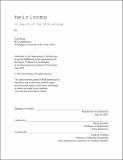heirlooms in search of the fifth ecology
Author(s)
Wong, Erin
DownloadThesis PDF (57.04Mb)
Advisor
Kennedy, Sheila
Terms of use
Metadata
Show full item recordAbstract
From the removal and displacement of indigenous peoples to gain land to grow cotton, to the creation of high-yielding modern seed varieties, agricultural practices over the past 200 years have created a broken and unsustainable system. Technological advances in plant genetics have fueled large scale-crop production, and a race to control one of our most important resources, seeds.
In the shadows, agro-chemical companies have amassed considerable control over the seed industry. Their efforts have resulted in a consolidation of seeds available for commercial use. So, while crop yields have increased, agriculture biodiversity has decreased. And since the 1900s the United States has lost over 90% of its fruit and vegetable varieties, spurring seed saving efforts around the world. The most well-known of these collective efforts is the Svalbard Global Seed Vault in Norway. Opened in 2008, the Global Seed Vault holds the world’s largest collection of agriculture biodiversity. The seeds lying in the deep freeze of the vault include wild and old varieties, many of which are not in general use anymore. But while the vault protects and preserves, the seeds hidden away, and frozen in time, wait to be woken.
We are now in a period known as the Awakening. A time that requires a new type of heirloom seed institution, one that is decentralized and accessible, one that designs for the entire life-cycle of the seed. Where once in nature, heirloom seeds found ways to move by themselves, by wind, by ocean current, in the bellies of animals, or by ballistic dispersal, they must now be supported by new heirloom seed practices. Therefore, urban centers, once removed from the life-cycle of the seed, are reintroduced as the site of an urban food culture. Told through a four-course meal, this is the story of the seed keepers of Los Angeles.
Date issued
2021-06Department
Massachusetts Institute of Technology. Department of ArchitecturePublisher
Massachusetts Institute of Technology